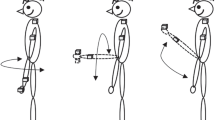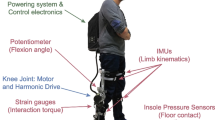Abstract
In patients with hemispheric stroke, abnormal motor performances are described also in the ipsilateral limbs. They may be due to a cortical reorganization in the unaffected hemisphere; moreover, also peripheral mechanisms may play a role. To explore this hypothesis, we studied motor performances in 15 patients with hemispheric stroke and in 14 patients with total knee arthroplasty, which have a reduced motility in the prosthesized leg. Using the unaffected leg, they performed five superimposed circular trajectories in a prefixed pathway on a computerized footboard, while looking at a marker on the computer screen. The average trace error was significantly different between the groups of patients and healthy subjects [F (2,25) = 7.9; p = 0.003]; on the contrary, the test time execution did not vary significantly. In conclusion, both groups of patients showed abnormal motor performances of the unaffected leg; this result suggests a likely contribution of peripheral mechanisms.





Similar content being viewed by others
References
Jebsen RH, Griffith ER, Long EW, Fowler R (1971) Function of the “normal” hand in stroke patients. Arch Phys Med Rehabil 52:170–174
Jones RD, Donaldson IM, Parkin PJ (1989) Impairment and recovery of ipsilateral sensory-motor function following unilateral cerebral infarction. Brain 112:113–132
Desrosiers J, Bourbonnais D, Bravo G, Roy PM, Guay M (1996) Performances of the “unaffected” upper extremity of elderly stroke patients. Stroke 27:1564–1570
Colebatch JG, Gandevia SC (1989) The distribution of muscular weakness in upper motor neuron lesions affecting the arm. Brain 112:749–763
Smutok MA, Grafman G, Salazar AM, Sweeney JK, Jonas BS, DiRocco PJ (1989) Effects of unilateral brain damage on contralateral and ipsilateral upper extremity function in hemiplegia. Phys Ther 69:195–203
Kim SH, Pohl PS, Luchies CW, Stylianou AP, Won Y (2003) Ipsilateral deficits of targeted movements after stroke. Arch Phys Med Rehabil 84:719–724
Andrews AW, Bohannon RW (2000) Distribution of muscle strength impairments following stroke. Clin Rehabil 14:79–87
Sunderland A, Bowers MP, Sluman S-M, Wilcock DJ, Ardron ME (1999) Impaired dexterity of the ipsilateral hand after stroke and the relationship to cognitive deficit. Stroke 30:949–955
Yelnik A, Bonan I, Debray M, Lo E, Gelbert F, Bussel B (1996) Changes in the execution of a complex manual task after ipsilateral ischemic cerebral hemispheric stroke. Arch Phys Med Rehabil 77:806–810
Winstein C, Pohl P (1995) Effects of unilateral brain damage on the control of goal-directed hand movements. Exp Brain Res 105:163–174
Carey JR, Baxter TL, Di Fabio RP (1998) Tracking control in the nonparetic hand of subjects with stroke. Arch Phys Med Rehabil 79:435–441
Hermsdorfer J, Laimgruber K, Kerkhoff G, Mai N, Goldenberg G (1999) Effects of unilateral brain damage on grip selection, coordination, and kinematics of ipsilesional prehension. Exp Brain Res 128:41–51
Nathan PW, Smith MC, Deacon P (1990) The corticospinal tracts in man. Course and location of fibres at different segmental levels. Brain 113:303–324
Cramer SC (1999) Stroke recovery. Lessons from functional MR imaging and other methods of human brain mapping. Phys Med Rehabil Clin N Am 10:875–886
Dewald JP, Beer RF, Given JD, McGuire JR, Rymer WZ (1999) Reorganization of flexion reflexes in the upper extremity of hemiparetic subjects. Muscle Nerve 22:1209–1221
Bertrand AM, Mercier C, Shun PL, Bourbonnais D, Desrosiers J (2004) Effects of weakness on symmetrical bilateral grip force exertion in subjects with hemiparesis. J Neurophysiol 91:1579–1585
Petersson IF, Boegard T, Saxne T, Silman AJ, Svensson B (1997) Radiographic osteoarthritis of the knee classified by the Ahlback and Kellgren & Lawrence systems for the tibiofemoral joint in people aged 35–54 years with chronic knee pain. Ann Rheum Dis 56:493–496
Thilmann AF, Fellows SJ, Garms E (1991) The mechanism of spastic muscle hypertonus. Variation in reflex gain over the time course of spasticity. Brain 114:233–244
Gauthier J, Bourbonnais D, Filiatrault J, Gravel D, Arsenault AB (1992) Characterization of contralateral torques during static hip efforts in healthy subjects and subjects with hemiparesis. Brain 115:1193–1207
Massion J (1992) Movement, posture and equilibrium: interaction and coordination. Prog Neurobiol 38:35–56
Gordon J, Ghilardi MF, Ghez C (1995) Impairments of reaching movements in patients without proprioception I. Spatial errors. J Neurophysiol 73:347–360
Ting LH, Raasch CC, Brown DA, Kautz SA, Zajac FE (1998) Sensorimotor state of the contralateral leg affects ipsilateral muscle coordination of pedaling. J Neurophysiol 80:1341–1351
Pap G, Meyer M, Weiler HT, Machner A, Awiszus F (2000) Proprioception after total knee arthroplasty: a comparison with clinical outcome. Acta Orthop Scand 71:153–159
Wada M, Kawahara H, Shimada S, Miyazaki T, Baba H (2002) Joint proprioception before and after total knee arthroplasty. Clin Orthop Relat Res 403:161–167
Hanlon CA, Buffington AL, McKeown MJ (2005) New brain networks are active after right MCA stroke when moving the ipsilesional arm. Neurology 64:114–120
Hasan Z (1992) Role of proprioceptors in neural control. Curr Opin Neurobiol 2:824–829
Pearson KG (1995) Proprioceptive regulation of locomotion. Curr Opin Neurobiol 5:786–791
Devanne H, Maton B (1998) Role of proprioceptive information in the temporal coordination between joints. Exp Brain Res 119:58–64
Zanette G, Manganotti P, Fiaschi A, Tamburin S (2004) Modulation of motor cortex excitability after upper limb immobilization. Clin Neurophysiol 115:1264–1275
Buchkremer-Ratzmann I, August M, Hagemann G, Witte OW (1996) Electrophysiological transcortical diaschisis after cortical photothrombosis in rat brain. Stroke 27:1105–1111
Buchkremer-Ratzmann I, Witte OW (1997) Extended brain disinhibition following small photothrombotic lesions in rat frontal cortex. NeuroReport 8:519–522
Butefisch CM, Netz J, Wessling M, Seitz RJ, Homberg V (2003) Remote changes in cortical excitability after stroke. Brain 126:470–481
Andrews RJ (1991) Transhemispheric diaschisis. A review and comment. Stroke 22:943–949
Cramer SC, Nelles G, Benson RR et al (1997) A functional MRI study of subjects recovered from hemiparetic stroke. Stroke 28:2518–2527
Cao Y, D’Olhaberriague L, Vikingstad EM, Levine SR, Welch KM (1998) Pilot study of functional MRI to assess cerebral activation of motor function after post-stroke hemiparesis. Stroke 29:112–122
Jaillard A, Martin CD, Garambois K, Lebas JF, Hommel M (2005) Vicarious function within the human primary motor cortex? A longitudinal fMRI stroke study. Brain 128:1122–1138
Brasil-Neto JP, Cohen LG, Pascual-Leone A, Jabir FK, Wall RT, Hallett M (1992) Rapid reversible modulation of human motor outputs after transient deafferentation of the forearm: a study with transcranial magnetic stimulation. Neurology 42:1302–1306
Sadato N, Zeffiro TA, Campbell G, Konishi J, Shibasaki H, Hallett M (1995) Regional cerebral blood flow changes in motor cortical areas after transient anesthesia of the forearm. Ann Neurol 37:74–81
Manganotti P, Patuzzo S, Cortese F, Palermo A, Smania N, Fiaschi A (2002) Motor disinhibition in affected and unaffected hemisphere in the early period of recovery after stroke. Clin Neurophysiol 113:936–943
Pohl PS, Winstein CJ (1999) Practice effects on the less-affected upper extremity after stroke. Arch Phys Med Rehabil 80:668–675
Acknowledgment
The authors thank Davide Cattaneo, Pht, from Fondazione Don Gnocchi of Milan, for his contribution on technical and methodological aspects of this study.
Author information
Authors and Affiliations
Corresponding author
Rights and permissions
About this article
Cite this article
Bagnato, S., Boccagni, C., Boniforti, F. et al. Motor dysfunction of the “non-affected” lower limb: a kinematic comparative study between hemiparetic stroke and total knee prosthesized patients. Neurol Sci 30, 107–113 (2009). https://doi.org/10.1007/s10072-009-0031-0
Received:
Accepted:
Published:
Issue Date:
DOI: https://doi.org/10.1007/s10072-009-0031-0




